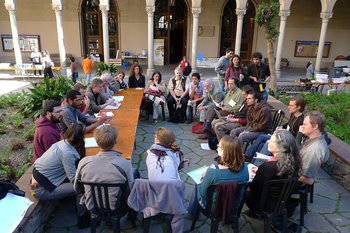Usability  Related Guides
Human Factors
| |
An information cascade is when an individual changes their behavior based on inferences they make by observing other people. The term implies that a person does something illogical that goes against facts that they know to be true due to a strong social urge to follow a crowd. The following are illustrative examples.
ComedyA Japanese comedy prank in which a large crowd suddenly appears on a quiet, narrow street running away from something. People caught by this gag typically join the crowd in running away. InvestingInvestors that buy into a stock that they know to be overvalued due to a fear of missing out. Products, services, brands and technologies may see sales suddenly grow very quickly after market penetration reaches a tipping point.
Hundredth Monkey EffectThe hundredth monkey effect is a story, that's probably a myth, about Japanese scientists and a study of macaque monkeys on Koshima island in 1952. The monkeys learned to wash sweet potatoes before eating them. This spread across the island as the monkeys can learn by observing one another. According to the story, when the number of sweet potato washing monkeys hit some critical number, ostensibly one hundred, the practice instantly jumped to other troupes of monkeys on other islands without any contact between the troupes. Although the story is thought to be a legend, it is a useful analogy to how ideas can spread quickly on a global basis once they hit a certain level of acceptance.|
Type | | Definition | When an individual acts on social information gained by observing people. | Related Concepts | |
Human Factors
This is the complete list of articles we have written about human factors.
If you enjoyed this page, please consider bookmarking Simplicable.
A list of human factors in design.
An overview of value sensitive design.
A definition of human readable.
A definition or error tolerance with examples.
The definition of decision fatigue with examples.
The definition of demographics with examples.
The definition of pessimism with examples.
The definition of achieved status with examples.
The definition of the human condition with examples.
A list of words for emotion.
A few basic influencing strategies.
The two ways that people accept ideas.
An overview of message framing as an influencing technique.
A definition of cultural capital with examples.
A definition of touch base with examples.
A definition of positive criticism with examples.
The common types of business story.
A definition of creative tension with examples.
The definition of consensus building with examples.
The definition of credibility with examples.
TrendingThe most popular articles on Simplicable in the past day.
Recent posts or updates on Simplicable.
Site Map
© 2010-2023 Simplicable. All Rights Reserved. Reproduction of materials found on this site, in any form, without explicit permission is prohibited.
View credits & copyrights or citation information for this page.
|































